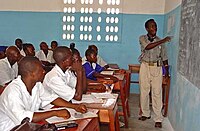
Photo from wikipedia
ABSTRACT Research Findings: The present study examined associations between children’s classroom interactions and teachers’ perceptions of teacher–child relationships during 1 year of preschool. Teachers (n = 223) reported their perceptions… Click to show full abstract
ABSTRACT Research Findings: The present study examined associations between children’s classroom interactions and teachers’ perceptions of teacher–child relationships during 1 year of preschool. Teachers (n = 223) reported their perceptions of closeness and conflict in their teacher–child relationships in the fall and spring. Children’s (n = 895) positive classroom interactions with teachers, peers, and learning activities and their negative interactions were observed midyear. Children’s positive interactions with teachers and learning activities predicted teachers’ perceptions of more closeness in the spring when we accounted for fall closeness. Children’s negative interactions predicted teachers’ perceptions of more relational conflict in the spring when we accounted for fall conflict. Children’s positive peer interactions did not predict spring closeness or conflict. Implications regarding teachers’ perceptions of teacher–child relationships and children’s independently observed classroom interactions are discussed. Practice or Policy: Findings provide empirical evidence for an aspect of Pianta, Hamre, and Stuhlman’s (2003) conceptual model of teacher–child relationships. Results indicate that children’s classroom interactions may be a factor related to how teachers report on their relationships with children across 1 year of preschool. Findings point to links between a range of children’s positive and negative interactions during typical instruction and teachers’ relationship perceptions.
Journal Title: Early Education and Development
Year Published: 2017
Link to full text (if available)
Share on Social Media: Sign Up to like & get
recommendations!